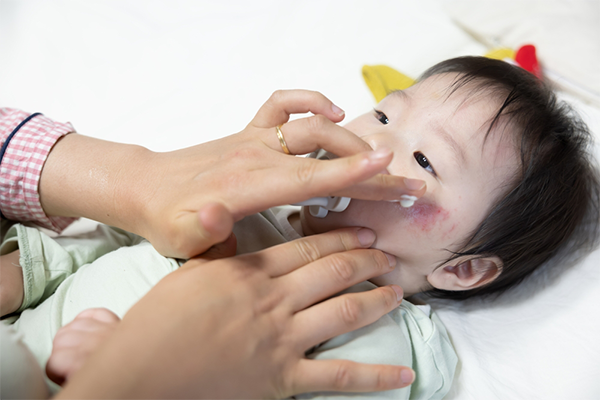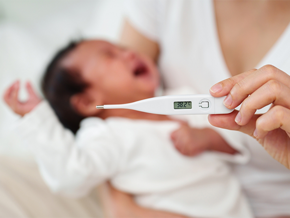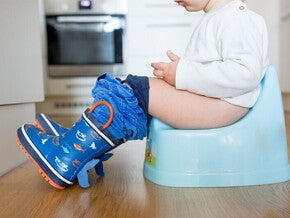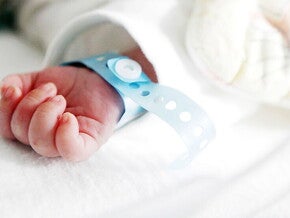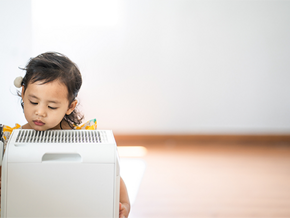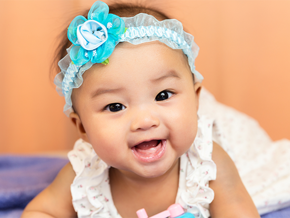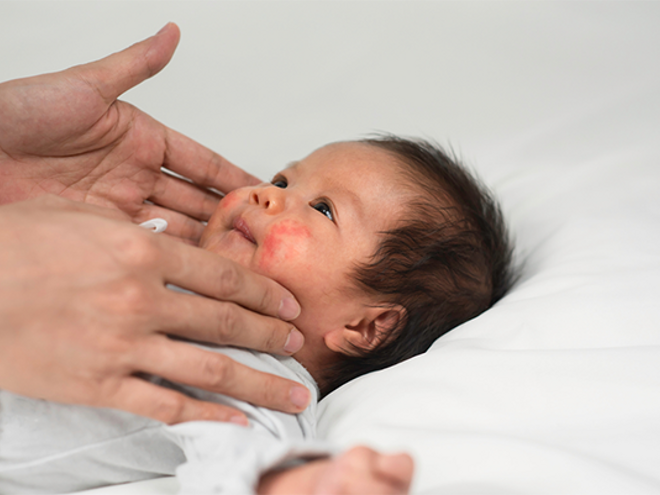
It can be worrying when you spot a baby rash, but proper care can make a significant difference. In fact, a 2025 scientific review in the Journal of Chemical Health Risks found that a good skincare routine (yes, even at this age!) can improve your little one's skin barrier by up to 40% and reduce skin problems by 35% in their first year.
From their bottoms to their cheeks, rashes can appear anywhere. Here’s how to recognize the most common baby rashes, plus simple steps you can do to soothe them at home.
1. Diaper Rash
The most common type of diaper rash is irritant dermatitis, which is characterized by red, irritated skin in the diaper area, sometimes accompanied by small bumps. According to the American Academy of Pediatrics (AAP), it's caused by prolonged contact with urine and stool.
Your baby can also develop a diaper rash due to a yeast (fungus) infection called Candida, which thrives in warm and moist places. AAP notes this type of rash appears as bright red or pink patches with sharp, defined borders or small pimple-like bumps. Your pediatrician can recommend the correct treatment if it's a yeast infection.
You can try these tips at home to manage common irritant diaper rash.
Change diapers frequently
The AAP advises changing your baby’s diaper as soon as it’s wet or soiled to minimize skin contact with irritants like pee and poop.
Let the skin air out
Allow your baby some diaper-free time on a towel each day. A 2025 global review in the Journal of Tissue Viability found that the most effective treatments for diaper rash all involve drying processes, whether through direct air exposure or the use of creams with moisture-absorbing ingredients.
Clean gently
Another tip from the AAP? Use warm water with a soft cloth or opt for fragrance-free wipes. Always pat the area dry, rather than rubbing, to avoid further irritation.
Create a barrier
You can also apply a thick layer of zinc oxide cream to shield the skin from moisture. A comprehensive 2025 review in the International Journal of Research in Medical Sciences found that zinc oxide is highly effective because it protects the skin, calms inflammation, fights germs, and promotes healing, making it a safe and reliable choice.
2. Heat Rash (Miliaria)
Common in warm climates, heat rash looks like tiny red or clear bumps on the neck, chest, or back. According to the UK's National Health Service (NHS), it occurs when sweat ducts become blocked, trapping sweat beneath the skin. This is common in babies as their sweat glands are still developing.
Here are simple, NHS-recommended steps you can take to help.
- Move your baby to a cooler, well-ventilated room.
- Dress your baby in loose-fitting, breathable cotton clothing.
- Apply a cool, damp cloth to the area for up to 20 minutes to soothe irritation.
- Avoid using heavy creams or perfumed soaps, as they can further clog pores.
3. Eczema (Atopic Dermatitis)
Eczema is a common baby rash that often appears on the cheeks and scalp. Daily moisturizing can make a big difference.
Eczema often appears in babies as dry, red, and itchy patches on their cheeks and scalp. It usually shows up when your baby has a weak skin barrier, which lets irritants in and triggers flare-ups. The risk is higher if eczema, asthma, or hay fever runs in the family.
Follow these steps for relief.
Moisturize, moisturize, moisturize!
Daily moisturizing is the foundation of eczema care, according to the official 2023 guidelines from the American Academy of Allergy, Asthma, and Immunology.
A simple and effective routine recommended by the American Academy of Pediatrics is to give your baby a short, lukewarm bath (5 to 10 minutes), gently pat the skin, and then immediately apply a thick, fragrance-free moisturizer all over to lock in hydration.
Identify and avoid potential triggers
Common triggers for sensitive skin include new laundry detergents, rough fabrics, or even a specific food if your baby has started solids. Keeping a simple log of flare-ups and exposures can sometimes help you spot a pattern.
4. Hives (Urticaria)
Hives look like raised, red welts or splotches that can appear suddenly. The AAP notes that they’re often a sign of an allergic reaction to food, medication, or insect bites, but can also be due to a viral infection.
To soothe itchy welts, gently apply a cool, damp cloth. Because allergies can cause hives, speak with your pediatrician regarding potential causes and treatments. Seek emergency medical help immediately if you notice any swelling of your baby’s lips or tongue, or if your baby has trouble breathing.
5. Cradle Cap (Seborrheic Dermatitis)
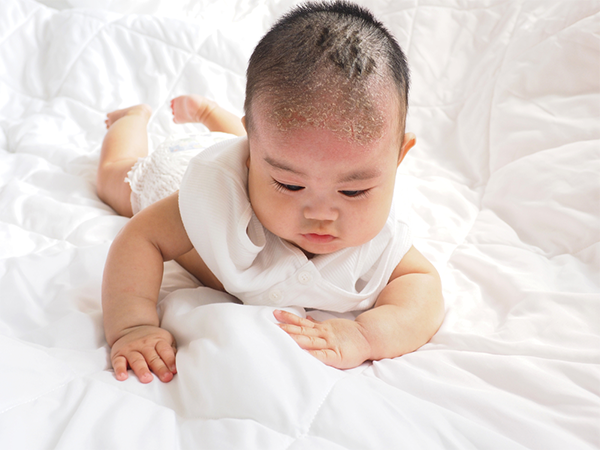
Cradle cap's scaly patches may look worrying, but this common rash is harmless and not usually itchy for your baby.
This type of rash appears as patchy, scaly, or greasy crusts on your baby's scalp. The scales may be white or yellow, but cradle cap is usually not itchy or painful for your baby.
According to the Mayo Clinic, the exact cause is unknown and is not related to poor hygiene. It’s thought to be a combination of maternal hormones that cause overactive oil glands and a common fungus (malassezia) that can grow in areas with excess oil.
Here's how to treat it:
- Gently wash your baby’s hair and scalp with a mild baby shampoo every few days. Regular washing helps reduce the buildup of scales and oil.
- Massage a small amount of baby oil or petroleum jelly into the scalp before bath time. Let sit for a few minutes, then use a baby brush to loosen the scales before shampooing.
6. Contact Dermatitis
As its name suggests, contact dermatitis occurs when your baby’s skin touches an irritating substance or an allergen. It’s generally divided into two main types.
Irritant contact dermatitis
This is the most common type and happens when a substance directly irritates the skin. A perfect example is a drool rash—a red, bumpy rash around your baby's mouth, chin, and neck, which is very common during teething. It’s caused by the constant moisture from saliva irritating their delicate skin.
Soothe your baby’s skin with these gentle tips.
- Keep the area dry by gently patting your baby's face and neck throughout the day with a soft cloth.
- Use a bib to catch the drool and change it when it gets damp.
- Apply a layer of petroleum jelly on the affected area to protect the skin from moisture.
Allergic contact dermatitis
This rash is an allergic reaction to a specific substance. It might look red, bumpy, or even blistered. Common triggers for babies include fragrances in lotions or soaps, dyes in clothing, certain metals (like nickel in snap buttons), or plants like Amorseko grass and Lipa (poisonous wood nettle).
Here’s what you can do to help manage it:
- Try to figure out what caused the reaction and keep it away from your baby's skin.
- Wash your baby's clothes, bedding, and towels in a mild, fragrance-free detergent.
- Use a gentle moisturizer and cool compresses to provide relief.
When to Call Your Pediatrician
While you can manage most cases at home, always call your doctor if:
- A fever accompanies the rash.
- The rash seems painful or blistering.
- The rash looks infected (has yellow crusts, pus, or red streaks).
- Your baby is unusually fussy, sleepy, or seems unwell.
- The rash doesn't improve after a few days of home care.
Most types of baby rash are often a temporary part of their first year, and you can manage it with simple home care. By understanding the common causes and knowing how to respond, you can confidently soothe your baby's skin and enjoy all the cuddles again.
Head on over to the ParentTeam Moms and Dads Facebook group and share your own tips for dealing with a baby rash with other parents!
References
Cleveland Clinic. “Hives in Children.” Cleveland Clinic. March 3, 2022. Accessed September 10, 2025. https://my.clevelandclinic.org/health/symptoms/22454-hives-in-children
Cleveland Clinic. “Skin Rashes in Kids.” Cleveland Clinic. June 19, 2025. Accessed September 10, 2025. https://my.clevelandclinic.org/health/diseases/6951-skin-conditions-in-children
Consolini, Deborah M. “Rash in Infants and Young Children.” MSD Manual Professional Version. March 2025. Accessed September 10, 2025. https://www.msdmanuals.com/professional/pediatrics/symptoms-in-infants-and-children/rash-in-infants-and-young-children
Deva, M., M.J. Netting, J. Weidinger, R. Brand, R.K. Loh, and S.L. Vale. “A Systematic Review of Guidelines for the Management of Atopic Dermatitis in Children.” World Allergy Organization Journal 17, no. 12 (2024). https://doi.org/10.1016/j.waojou.2024.100989
Dix, Megan. “How to Spot and Take Care of Your Baby’s Rash.” Healthline. January 16, 2019. Accessed September 10, 2025. https://www.healthline.com/health/how-to-spot-and-take-care-of-your-babys-rash
Hebert, Adelaide A. “A New Therapeutic Horizon in Diaper Dermatitis: Novel Agents with Novel Action.” International Journal of Women's Dermatology 7, no. 4 (2021): 466–70. https://doi.org/10.1016/j.ijwd.2021.02.003
Mayo Clinic. “Common Baby Rashes.” Mayo Clinic. March 29, 2024. Accessed September 10, 2025. https://www.mayoclinic.org/healthy-lifestyle/infant-and-toddler-health/in-depth/baby-rashes/art-20546833
Ojeda, Anthonella B. Benitez, and Magda D. Mendez. "Diaper Dermatitis." In StatPearls. Treasure Island, FL: StatPearls Publishing, 2023. https://www.ncbi.nlm.nih.gov/books/NBK559067/
Perno, Joseph Frank. “Common Pediatric Rashes.” Johns Hopkins Medicine. n.d. Accessed September 10, 2025. https://www.hopkinsmedicine.org/health/conditions-and-diseases/skin-conditions/common-pediatric-rashes
Timmons, Jessica. “How Best to Treat and Prevent a Drool Rash.” Healthline. February 3, 2023. Accessed September 10, 2025. https://www.healthline.com/health/parenting/drool-rash
Wilborn, Doris, Ruhul Amin, Jan Kottner, and Ulrike Blume-Peytavi. “Skin Care in Neonates and Infants: A Scoping Review.” Skin Pharmacology and Physiology 36 (2023). https://doi.org/10.1159/000529550










